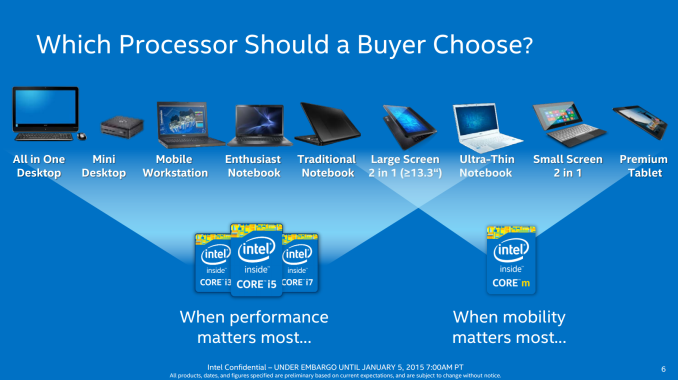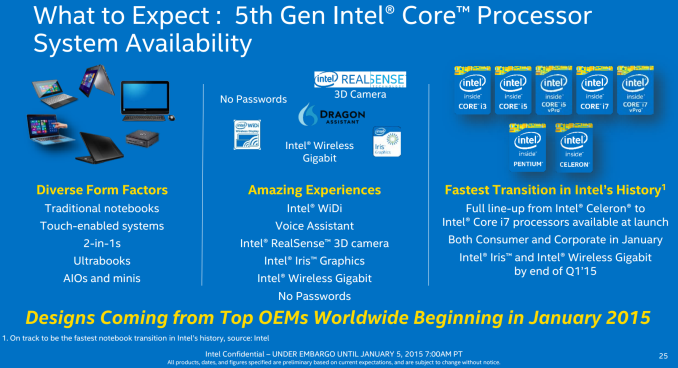Intel Releases Broadwell-U: New SKUs, up to 48 EUs and Iris 6100
by Ian Cutress on January 5, 2015 10:00 AM ESTFitting in With Core M
The staggered release of Broadwell is nothing new. Previous releases from Intel has seen them pick a particular market and aim at that first, whether it be tablet, mobile devices, ultrabooks or desktops, with the rest to follow. Core M, Intel’s 4.5 W ‘Broadwell-Y’ part, has been in the market for over a month with designs such as the Lenovo Yoga 3 Pro, although the number of SKUs available as well as worldwide distribution has been relatively slow, with the designs featuring Core M being expensive in terms of casual computing and more premium upgrades. Broadwell-U changes this by opening up the power envelope, and as such Intel sees the market at follows:
The Broadwell-U processors from Intel are aiming to give enough performance from AIO desktop systems to mini desktops, premium mobile applications all through to large 2-in-1s. There is some overlap with Core M, particularly with the 7.5W cTDP down elements of the range, but the interesting element will be pricing. The Celerons come in around $100, with the Pentium at $160, but then it gets expensive for Broadwell-U. $275 to $315 covers all the i3 and i5 parts both at 15W and 28W, ending with $393/$426 for the i7 parts. Further to my efficiency comments above, on paper at least the i5-5350U or i5-5250U would seem the most interesting processors of the bunch.
Release Dates
In our conference call with Intel, it was clear that these CPUs are shipping to their partners today. Throughout CES there will be a number of manufacturers announcing their products, and as per the norm Intel allows the partners to introduce their own products, rather than showing examples of where Broadwell-U fits in. However, because Broadwell-U is designed to be pin-compatible with Haswell-U, we might see some manufacturers purely re-releasing some of their designs with the newer CPU and a firmware update. Nevertheless, Intel is expecting OEM systems with Broadwell-U to start shipping in North America within the month. Designs with Iris graphics, or those featuring Intel based WiGig connectivity, will be more towards the end of Q1. Overall Intel is tracking ‘hundreds of designs’ involving Broadwell, indicating that it will be a significant push to bring 14nm to the market.












85 Comments
View All Comments
Pork@III - Friday, January 16, 2015 - link
Yes with Skylake we have a few new intructions; new memory controller, eDRAM on die area, also few other arcitectural changes. With all these changes together Intel promise significant progress in computational capacity of this generation processors. Intel did not once have promised more than what actually imagined their customers. But we still have hope.jman9295 - Sunday, January 18, 2015 - link
Intel should think about producing a mid-range quad core without HT and without the HD graphics GPU specifically for gaming laptops that come with discrete Nvidia GPUs. Before, it made sense to have the iGPU for non-gaming situations to keep the battery from draining. The laptop would switch back and forth automatically. Now, though, with Maxwell being designed as a mobile architecture from the start, there has to be some way that Nvidia can disable most of the GPU so that it can operate at extremely low power consumption when browsing or doing light tasks. I don't think Intel has ever had a mobile core-i CPU with 4 physical cores and no HT. And I'm pretty sure there never was a mobile core-i CPU that did not have an iGPU. Right now, gamers have the choice of a 4c/8t i7 or a 2c/4t i5 or i7 and nothing in between. Giving us a 4c/4t i5 would bring the cost of halfway decent gaming laptops down to under $1,000 depending on the GPU installed. I'm sure there are plenty of other applications for a mobile CPU like this other than gaming, but this would be the ideal gaming laptop CPU.tipoo - Sunday, January 18, 2015 - link
Why does each EU handle 7 threads, when they have 8 "shaders" each?tipoo - Sunday, January 18, 2015 - link
I have the Iris Pro 5200, I'll be interested to see where that 6100 falls in comparison to it. More EUs, and the other benefits to the small GPU-level caches, but no eDRAM. I think the 5200 should still beat it, but I wonder how close it can come without eDRAM.boe - Wednesday, February 4, 2015 - link
I'd certainly like to know more about the onboard GPU for HTPCs. Will it support 4K@60? 4K 3D specs etc.